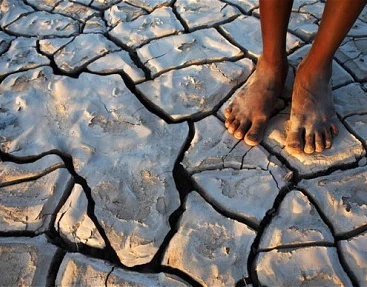Africa is on its knees for climate change while we rejoice in an almost Spring-like Autumn
No, it is not a good thing at all that it is still hot in November and people are walking around Italy in T-shirts. While we pretend that this is normal, Africa is fighting the dangerous battle against climate change without arms.

Let’s take a closer look at the consequences, often kept quiet, of the raging climate crisis that is bearing down on the African continent, already exhausted between internecine wars and serious political instabilities. November 2022 is also the month of COP27, the United Nations Conference on Climate Change, this year scheduled to take place in Sharm El Sheikh, Egypt.
It should be absolutely emphasized that the countries of Africa have hardly ever contributed to the emergence of these changes. According to historical trends, their emissions of CO2 and other greenhouse gases have always been globally negligible and only South Africa exceeds 1% of total global emissions.
“Africa, the continent with the lowest total greenhouse gas emissions, is seeing temperatures rising faster than the global average. Africa is at the forefront of the current crisis,” says Ms. Pobee, a UN Departments of Political and Peacebuilding Affairs and Peace Operations officer.
The next paragraphs are intended to give an overview of the contingent situation in Africa. It is all happening exactly now as you proceed to read this article.
NIGERIA: increasingly violent floods
The country is facing years of the worst flooding in a decade. Hundreds have lost their lives, there are more than 1.3 million displaced people and the UN estimates that more than 2.8 million people affected due to the flooding of 440,000 hectares of farmland and infrastructure.
In northeastern Nigeria, water flooded IDP sites and host community villages, forcing residents to flee to the highlands. Authorities blame both heavy rains and subsequent flooding from the Lagdo Dam, in neighboring Cameroon.

SOMALIA: a raging drought
Radically different story for Somalia. The last four rainy seasons have not happened and it is very likely that even the fifth will be less than needed. Crops cannot grow to their full potential, which is why millions of livestock have already died as a result of the current drought.
This is the third drought in Somalia within a decade. The first drought in 2011 killed about 260,000 people, many of whom were children, while the worst consequences of the second, in 2017, were fortunately mitigated by the early warning systems that came into operation, rapid donations, and more robust government institutions.
BURKINA FASO: a disappearing biodiversity
Another consequence, not so well known to most, of climate crises concerns the loss of biodiversity. Certain plants are disappearing or thinning out fast: even plants that are part of traditional medicine and actually useful for healing are disappearing.
In addition, a particular kind of thatch grows in these areas that are used to make canopies that keep the cool inside the house, but it is getting harder and harder to find. So they resort to other materials – sheet metal or plastic – which are not as comfortable and are not environmentally sustainable, again feeding the vicious cycle.
CHAD: the lake that retracts more and more
For centuries, Lake Chad sustained agricultural production and was a lifeline for fishing, farming, and livestock, the mainstays of the region’s economy.
However, in recent decades, climate variability has significantly reduced the size of the lake and its resources, losing an astonishing 90% of its volume since the 1960s.
The alarming depletion of the lake’s resources is the result of rising temperatures, desertification, soil infertility, and other environmental degradations. In addition, climate change has drastically reduced livestock breeding and crops in the country.

KENYA: the dangerously expanding lake
Paradoxically in contrast to Chad, in the past decade Kenyan Lake Baringo has doubled in size due to a massive increase in rainfall. Now, its waters have become a real threat to the inhabitants forced to leave, since the expanding lake has flooded homes and brought crocodiles and hippos right up to the doorsteps of homes and schools in the nearest villages.
The lake has always been a crucial freshwater reservoir, but scientists fear that as it continues to expand at this rate, it could merge with a large salt lake nearby, Lake Bogoria, which is also expanding, thereby contaminating the precious freshwater supply.
SOUTH SUDAN: a European country intervenes
The increasingly unstable rainy season has exacerbated food insecurity: 60% of the population does not have continuous access to daily food needs. To put this into perspective, the typical soil in South Sudan is called black cotton soil because it resembles cotton’s ability to soak and retain water, making it a problem for farmers and livestock breeders.
Camps for IDPs are currently located below the water line, protected only by makeshift dams formed by barriers of compacted soil. Twenty-four hours a day are being worked with pumps, buckets, diggers, and machinery to keep the water at bay and prevent such dams from collapsing. In addition, the same trucks that bring food and other necessities cannot reach those in need because the roads are cut off by water.
The International Organization for Migration (IOM), the government of the Netherlands, and the government of South Sudan have launched a new project to address concerns about climate change. The four-year project aims to strengthen the government’s capacity to develop climate-resilient warning systems and infrastructure to reduce the impacts of climate change, and reportedly more than 100,000 people will benefit from this pilot project.
ZIMBAWE: even animals are forced to move
The Rewild Zambezi Project recently kicked off, involving the relocation of some 400 elephants, 2,000 impalas, 70 giraffes, 50 buffalos, 50 wildebeests, 50 zebras, 50 antelopes, 10 lions, and a herd of 10 lycaons from a Southern reserve to three reserves in the North to save them from drought in a 700- kilometers journey. The ravages wrought by climate change pose the greatest threat to wildlife, surpassing even the damage wrought by poaching.
This is obviously no small feat, involving a large number of men and vehicles. While a helicopter tries to herd impalas into a giant enclosure, a crane loads a sedated elephant onto a truck and, with the help of rangers, many other animals are confined in metal cages.

It is there for all to see: climate change is happening. Do we want to do something about it?


